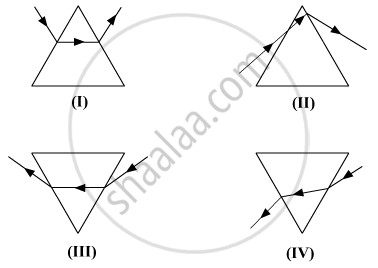Advertisements
Advertisements
प्रश्न
While performing the experiment to trace the path of a ray of light passing through a glass prism, four students marked the incident ray and the emergent ray in their diagrams in the manner shown below. 
(A) I
(B) II
(C) III
(D) IV
उत्तर
(C)
When light goes from rarer medium to denser medium; it bends towards the normal and vice-versa. This condition is fulfilled in figure (III).
APPEARS IN
संबंधित प्रश्न
State the cause of dispersion of white light
In an experiment to trace the path of a ray of light through a glass prism for different values of angle of incidence a student would find that the emergent ray:
(A) is parallel to the incident ray
(B) perpendicular to the incident ray
(C) is parallel to the refracted ray
(D) bends at an angle to the direction of incident ray
An object AB is placed in front of a convex lens as shown in fig. 4. Complete the ray diagram and obtain the image formed and state the nature of the image.

Draw a labelled diagram: Dispersion of light through a prism.
What do you understand by spectrum? Name the seven prominent colours in order, as obtained in the spectrum of white light.
The process of separation of light into its component colours while passing through a medium is called _______.
Say TRUE or FALSE
Rainbow is formed by dispersion of which light by water drops
Define dispersion of light.
Name the scientist who was the first to use a glass prism to obtain the spectrum of sunlight.
When sunlight passes through water droplets in the atmosphere it gets dispersed into its constituent colours forming a rainbow. A similar phenomenon is observed when white light passes through a prism.
Instead of sunlight, a green-coloured ray is passed through a glass prism. What will be the colour of the emergent ray?
